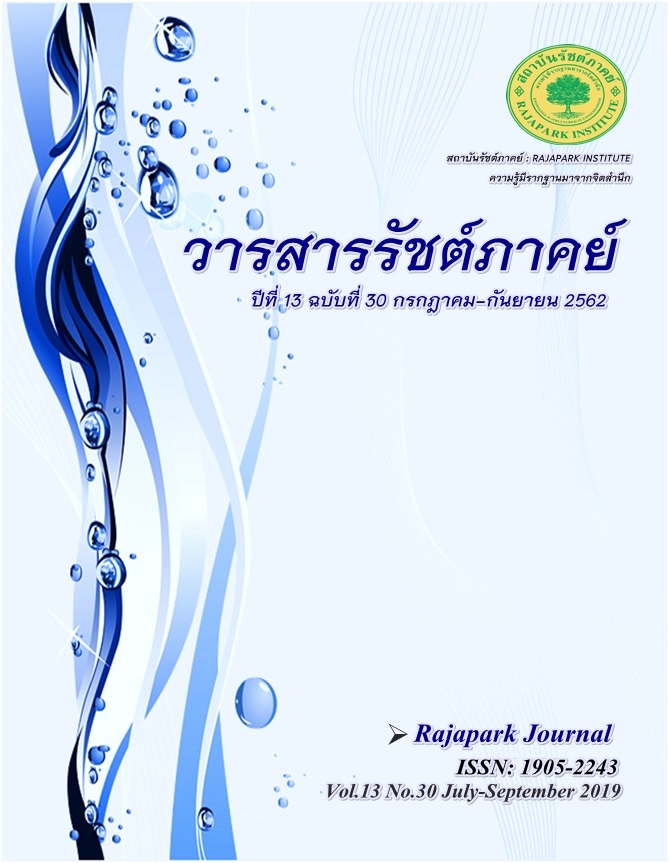Application of Creative Economy to Reed Mats Products of Nongkoh Village, Ta Triang Tia District, Amphoe Landuan, Surin Province
Main Article Content
Abstract
This research aims to study the local wisdom on reed mat production as well as proposing guidelines for raising the level of reed mat products by applying creative economy at Nongkoh Village, Ta Triang Tia Sub-district, Lamduan District, Surin Province. Using qualitative research methods which main contributors are community leaders, village headmen, members of SAO, teachers, monks, and members of the reed mats group, totaling 50 people. Interviewing and participatory observation were used for data collection and analyzed with content analysis techniques. The results found that original wisdom of reed mat products used local resources Transformed into mats for use and exchange in the community. There is a process inherited from the elderly or those who have knowledge and advice for children using a hand-woven pattern on the floor. There are basically 2 types of materials used to weave; standing lines, using jute and line using the triangle papyrus. These local wisdoms has been transferred from the ancestors to their next generation. The main raw material for weaving reed mats is the queen Papyrus which products of the group include folding mat, roll mat, asana, and etc. The highlight of the product is hand-made, hand-woven method, sitting on the floor and made from local ingredients while the weakness are a form of product that does not have variety, no unique pattern and chemical dyed. The guidelines for product upgrading are developing the product to have a variety of styles and developing patterns that are unique to the local area. Furthermore, design and packaging should focus on the naturally colored. This trend is preferred by the international market and it is also reduce production costs. Training should also be provided on product quality control in standard and providing knowledge on creating a practical business plan in order to reduce operational risks.
Article Details

This work is licensed under a Creative Commons Attribution-NonCommercial-NoDerivatives 4.0 International License.
Views and opinions appearing in the Journal it is the responsibility of the author of the article, and does not constitute the view and responsibility of the editorial team.
References
Chutiboot, M. & Chomphulong, N. (1995). Guidelines for Using Local Wisdom in Teaching and Learning. Bangkok: Aksorncharoentat.
Department of Intellectual Property. (2008). Intellectual property laws in foreign countries. Retrieved January 8, 2018, from https://www.ipthailand.org/ipthailand/index.php?option=com_docman&Itemed=600
Parrish, D. (2013). T-Shirts and Suits, Thailand Creative & Design Center. Retrieved January 8, 2018, from https://library.tcdc.or.th/record/view/b00021510.
Petpaow, P. (2014). The process of the creative economy to raise OTOP products to the international level of Tambol Don Tum, Banglen District, Nakhonpathom Province. Veridian E-Journal, Silpakorn University, 7(1), 369-378.
Pholphirul, P. (2013). Creative Economy and Development Issues in Thailand. NIDA Economic Review, 7(1), 1-69.
Kiddee, U. (2011). Alternative: Local wisdom knowledge management on reed mats of Banpang Community, Mahasarakham Province. Master's thesis in the Master's Degree of Public Administration in the Local Government College of Local Administration. Khonkaen University.
Samakoses, V. (2010). Handout on the Creative Economy of Chanthaburi. Chanthaburi: Published by Office Depot Chanthaburi Province.
Sisalap, N. (2011). Thai Wisdom. Retrieved March 31, 2014, from https://info.muslimthaipost.com/main/index.php?page=sub&category=29&id=4679#
Wingwon, B. et al. (2014). Approach in Creating Local Wisdom with Creative Product Innovation of Small Enterprises in Hang Chat District, Lampang Province. Journal of Management Science Chiangrai Rajabhat University, 9(1), 102–119.


